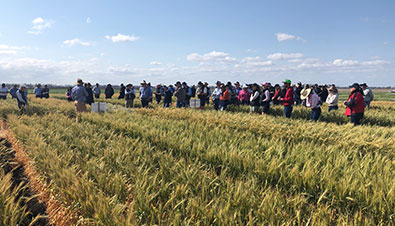Field days provide invaluable opportunities for growers, agricultural professionals and extension workers to learn about the latest farming technology, different seed varieties and techniques to boost production.
 These events are a hive of activity with people and vehicles moving around, creating opportunities for hitchhiking pests and diseases to spread.
These events are a hive of activity with people and vehicles moving around, creating opportunities for hitchhiking pests and diseases to spread.
Key biosecurity risks for field days include:
- introducing an unwanted pest or disease to the field site
- visitors taking a pest or disease back to their property
- spread of pests or diseases throughout the district or even further.
Managing these risks can be simple, safeguarding all involved in hosting and attending field days
Top 10 biosecurity tips for field days:
- Include a biosecurity message in publicity fliers. For example: ‘In the interest of farm biosecurity, please ensure all footwear and vehicles are free of soil’.
- Ensure all vehicles are parked in a designated area. This can help to contain the spread of a new pest and make monitoring for new pests and weeds much easier.
- Consider using a bus for transport to field sites to reduce the risks associated with vehicle movement.
- Set up boot scrapers and a foot bath at site access points. These can be located either at the entry to the property, and prior to getting back on a bus.
- Have hand washing facilities and sanitiser available for use.
- Register all attendees. This can help to trace the origin and spread of new pests and diseases that might occur as a result of the field day.
- Ensure the field site has biosecurity signage. Signs can remind attendees of the importance of biosecurity and requirements at the site.
- Remember that caterers, trade or industry representatives, and hired staff erecting marquees should also comply with field day hygiene guidelines.
- Monitor the car park and the sites visited for signs of any new diseases, pests or weeds for up to a year after the event. New pests can take a while to show up and your obligation to the site should not end with the field day.
- Remind attendees of the risks and encourage good farm biosecurity practice. This can include advice for attendance at future field days, as well as information on good farm biosecurity practice.
There are several risks involved if farm biosecurity is not considered such as introducing a new pest to an area with associated control and management issues, which could possibly become a long-term problem.
Biosecurity is everyone’s responsibility, which means organisers, growers and visitors are obligated to minimise biosecurity risks to ensure the future of Australia’s grains industry.
The Grains Farm Biosecurity Program (GFBP) developed a fact sheet to explain how to prevent field days and on-site trials from becoming occasions to spread pests and weeds.
If you see anything unusual, please report it to the Exotic Plant Pest Hotline on 1800 084 881.
Acknowledgement: This article was edited with permission from an article that was originally published by the Grains Farm Biosecurity program.
 These events are a hive of activity with people and vehicles moving around, creating opportunities for hitchhiking pests and diseases to spread.
These events are a hive of activity with people and vehicles moving around, creating opportunities for hitchhiking pests and diseases to spread.